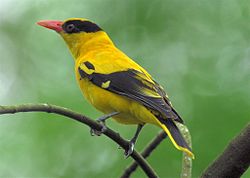| Oriolidae | |
|---|---|
 | |
| Black-naped oriole (Oriolus chinensis) | |
| Scientific classification | |
| Kingdom: | Animalia |
| Phylum: | Chordata |
| Class: | Aves |
| Order: | Passeriformes |
| Superfamily: | Orioloidea |
| Family: | Oriolidae Vigors, 1825 |
| Type genus | |
| Oriolus Linnaeus, 1766 | |
| Genera | |
See text | |
The Old World orioles (Oriolidae) are an Old World family of passerine birds. The family contains 41 species which are divided in 4 genera. The family includes two extinct species from New Zealand that are placed in the genus Turnagra .


